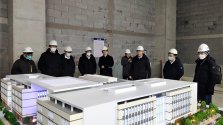The article states the SSMB will be constructed in XNA (Hebei). What's Guangzhou got to do with it?China has synchrotron in Guangzhou
You are using an out of date browser. It may not display this or other websites correctly.
You should upgrade or use an alternative browser.
You should upgrade or use an alternative browser.
Chinese semiconductor industry
- Thread starter Hendrik_2000
- Start date
- Status
- Not open for further replies.
The larger the synchrotron the longer it takes to build.Source for this? The SSMB is a synchrotron (granted, a small one) and in China those typically take 5 years from the start of construction to first operation.
Yes, that's obvious and I alluded to it in the post. However, the number of years it takes to build isn't a function of circumference. There's going to be some chunk of time that's constant no matter the size of the synchrotron (producing and installing equipment, training personnel, etc.) A 2025 date is really pushing it, even if its Q4 2025 and construction begins immediately.The larger the synchrotron the longer it takes to build.
I think 2027/8 is more reasonable.
The research team of Professor Peng Lianmao and Researcher Qiu Chenguang from the School of Electronics, Peking University has prepared a 10nm ultra-short channel ballistic two-dimensional indium selenide transistor, which for the first time makes the actual performance of the two-dimensional transistor exceed Intel's commercial 10nm node silicon-based Fin transistor, and The working voltage of the two-dimensional transistor is reduced to 0.5 V, which is also the fastest and lowest power consumption two-dimensional semiconductor transistor in the world so far. The relevant research results are titled "Ballistic two-dimensional InSe transistors" and published online in the journal Nature on March 22, 2023. Doctoral students Jiang Jianfeng and Dr. Xu Lin from the School of Electronics are the co-first authors, Professor Peng Lianmao and researcher Qiu Chenguang are the co-corresponding authors, and the School of Electronics of Peking University is the sole unit of the paper.
| 北京大学电子学院彭练矛教授、邱晨光研究员课题组制备了10纳米超短沟道弹道二维硒化铟晶体管,首次使得二维晶体管实际性能超过Intel商用10纳米节点的硅基Fin晶体管,并且将二维晶体管的工作电压降到0.5 V,这也是世界上迄今速度最快能耗最低的二维半导体晶体管。 相关研究成果以“Ballistic two-dimensional InSe transistors”为题,2023年3月22日在线发表于Nature期刊。电子学院博士生姜建峰与徐琳博士为并列第一作者,彭练矛教授和邱晨光研究员为共同通讯作者,北京大学电子学院为论文唯一单位。 |
But Synchrotrons easily produce radiation in all ranges of the EM spectrum, from long to x-rays, no?SSMB is just light source. The is a lot more than light source in EUV machine,let along EUV photoresist,EUV mask etc.
yes, synchrotron is tunable. but the reason why people picked EUV over X-ray is due to the X-ray photoresist problem (no material absorbs X-rays well enough) and the X-ray mask problem (X-rays too short to manage with projection optics). Exactly 13.5 nm EUV itself has problems too, but luckily they've been solved generously by others, so China only has to manage a novel light source.But Synchrotrons easily produce radiation in all ranges of the EM spectrum, from long to x-rays, no?
So if china can crack the x-ray mask and x-ray photo resist problems in the future China can just upgrade those newly built EUV infrastructure to X-ray light source infrastructure?yes, synchrotron is tunable. but the reason why people picked EUV over X-ray is due to the X-ray photoresist problem (no material absorbs X-rays well enough) and the X-ray mask problem (X-rays too short to manage with projection optics). Exactly 13.5 nm EUV itself has problems too, but luckily they've been solved generously by others, so China only has to manage a novel light source.
- Status
- Not open for further replies.

